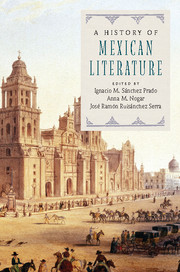Book contents
- Frontmatter
- Contents
- List of contributors
- Introduction
- PART I COLONIAL LITERATURE
- 1 The Languages and Literatures of Early Print Culture in the Colonia
- 2 A Chronicon of Crónicas: The New Spanish Prose Narrative
- 3 Theatricality and the Public Enactment of the Mexican Colonial
- 4 Sor Juana Inés de la Cruz: The Tenth Muse and the Difficult Freedom to Be
- 5 Jesuit Enlightenment: Interventions in Christianity and Intellectualism
- 6 Women in the Print Culture of New Spain
- 7 The Colonial Literary Scope: Empire, Letter, and Power
- 8 New Spain's Archival Past and Present Materiality
- PART II THE NINETEENTH CENTURY
- PART III TWENTIETH AND TWENTY-FIRST CENTURIES
- PART IV MEXICAN LITERATURE BEYOND BOUNDARIES
- Index
- References
7 - The Colonial Literary Scope: Empire, Letter, and Power
from PART I - COLONIAL LITERATURE
Published online by Cambridge University Press: 05 July 2016
- Frontmatter
- Contents
- List of contributors
- Introduction
- PART I COLONIAL LITERATURE
- 1 The Languages and Literatures of Early Print Culture in the Colonia
- 2 A Chronicon of Crónicas: The New Spanish Prose Narrative
- 3 Theatricality and the Public Enactment of the Mexican Colonial
- 4 Sor Juana Inés de la Cruz: The Tenth Muse and the Difficult Freedom to Be
- 5 Jesuit Enlightenment: Interventions in Christianity and Intellectualism
- 6 Women in the Print Culture of New Spain
- 7 The Colonial Literary Scope: Empire, Letter, and Power
- 8 New Spain's Archival Past and Present Materiality
- PART II THE NINETEENTH CENTURY
- PART III TWENTIETH AND TWENTY-FIRST CENTURIES
- PART IV MEXICAN LITERATURE BEYOND BOUNDARIES
- Index
- References
Summary
In the viceroyalty of New Spain – as what is now Mexico was called during the colonial period – juridical, social, and economic institutions codified power relations. These institutions followed the basic premise of Spanish imperial sovereignty: that the conquest had established a contractual relationship between indigenous vassals and the Castilian Crown. After intense debate between theologians and humanists over the Crown's right to possess and govern overseas territories, this premise was expressed in a series of sixteenth-century Spanish laws defining conquest and administration. Effective governance in New Spain, however, depended on the informal authority of patrimonialism and took two major forms: clientelism, consolidated through the exchange of favors, and forced labor, in the form of slavery or tribute requirements backed by juridically sanctioned violence.
Written documents defined social subjects and spaces in New Spain in accordance with these practices of patrimonial governance. Following the seminal study by Ángel Rama, scholars often refer to a colonial “lettered city” whose frontiers defined social identities based on the ability to read and write. Yet the written word should not be conceived of as a static boundary but rather as a medium that registered and permitted emerging political relations among social groups in New Spain. To investigate the way in which writing articulated colonial politics, the following article does not propose a comprehensive list of literary genres and authors, nor does it argue for a new canon of literary texts. Instead, it focuses on three settings for the practice of governance in seventeenth- and eighteenth-century New Spain: the viceregal court, urban space, and the church. Through their engagement with emerging forms of viceregal governance, writings about these social spaces make visible the relationship between writing, governance, and power in a society that balanced military conquest with local patrimonialism.
The Poetic Economy of the Viceregal Court
By the end of the sixteenth century, the Spanish monarch Phillip II governed the most extensive imperial territory the world had seen. While the Spanish Empire was defined during its first two centuries by the relatively loose rule of the Austrian Habsburg monarchy, long-distance governance and the dire finances of the Crown forced the introduction of a more centralized system of administration, including alternative channels for revenue through labor and tribute.
- Type
- Chapter
- Information
- A History of Mexican Literature , pp. 113 - 127Publisher: Cambridge University PressPrint publication year: 2016
References
- 1
- Cited by



